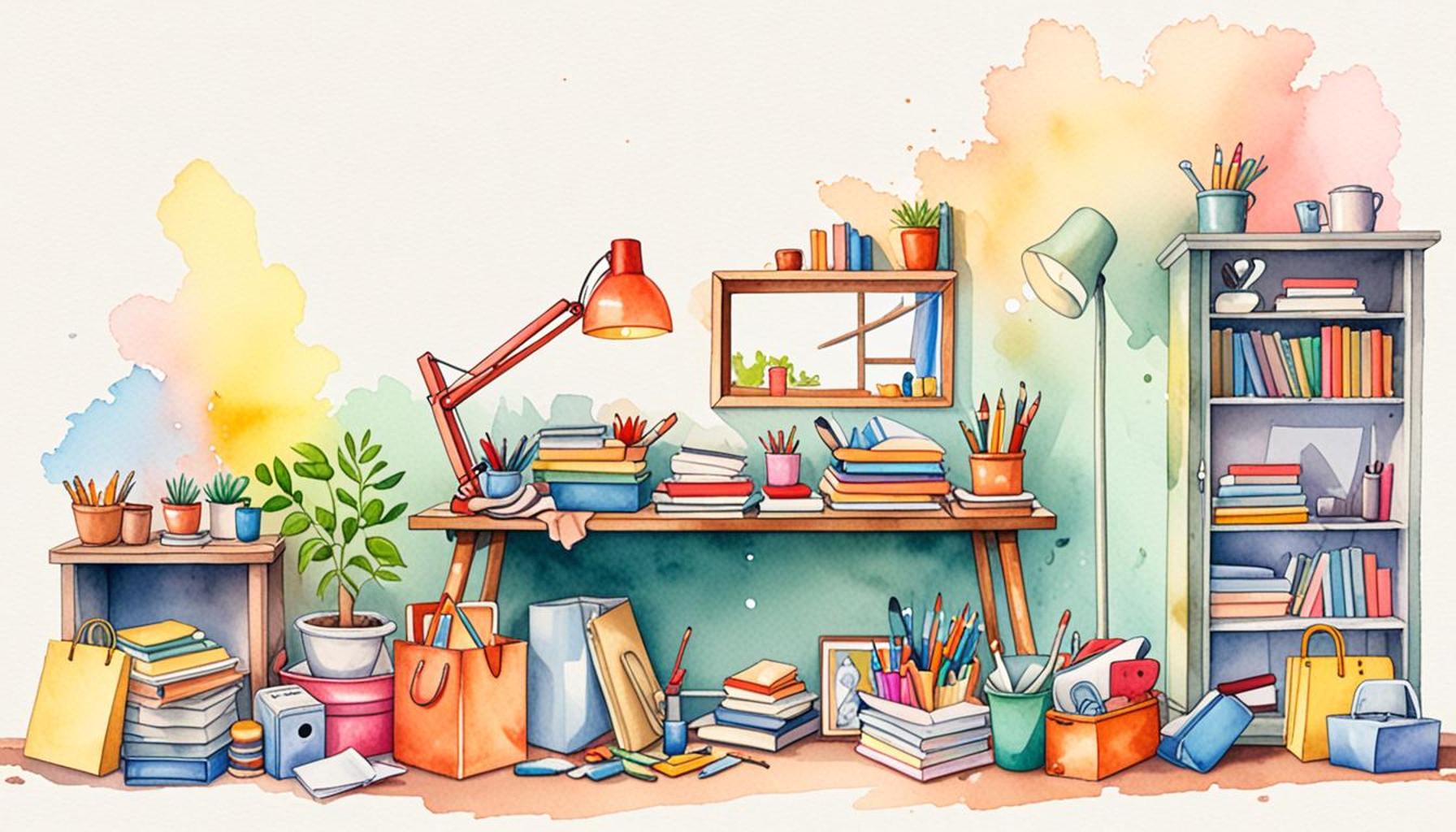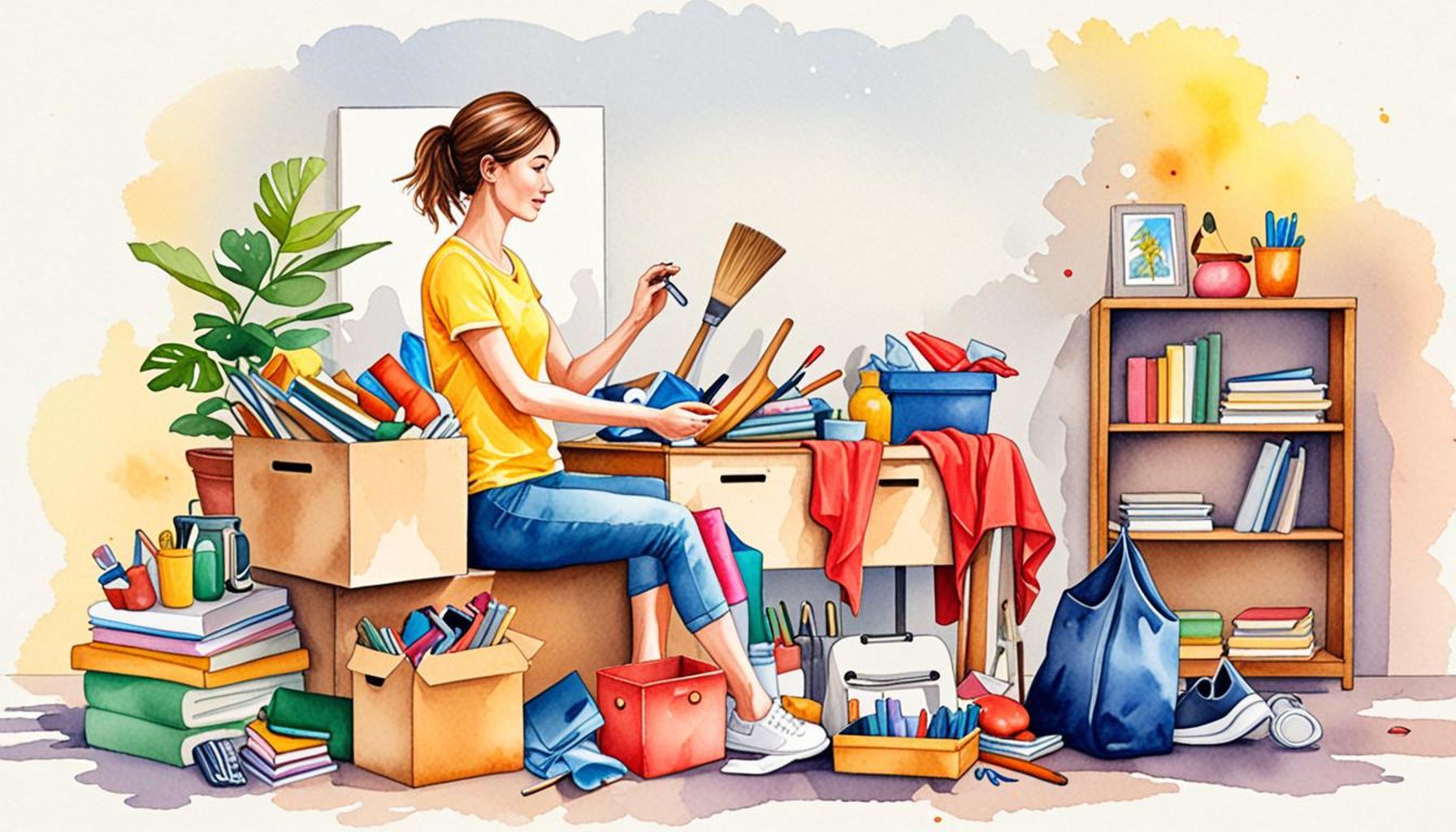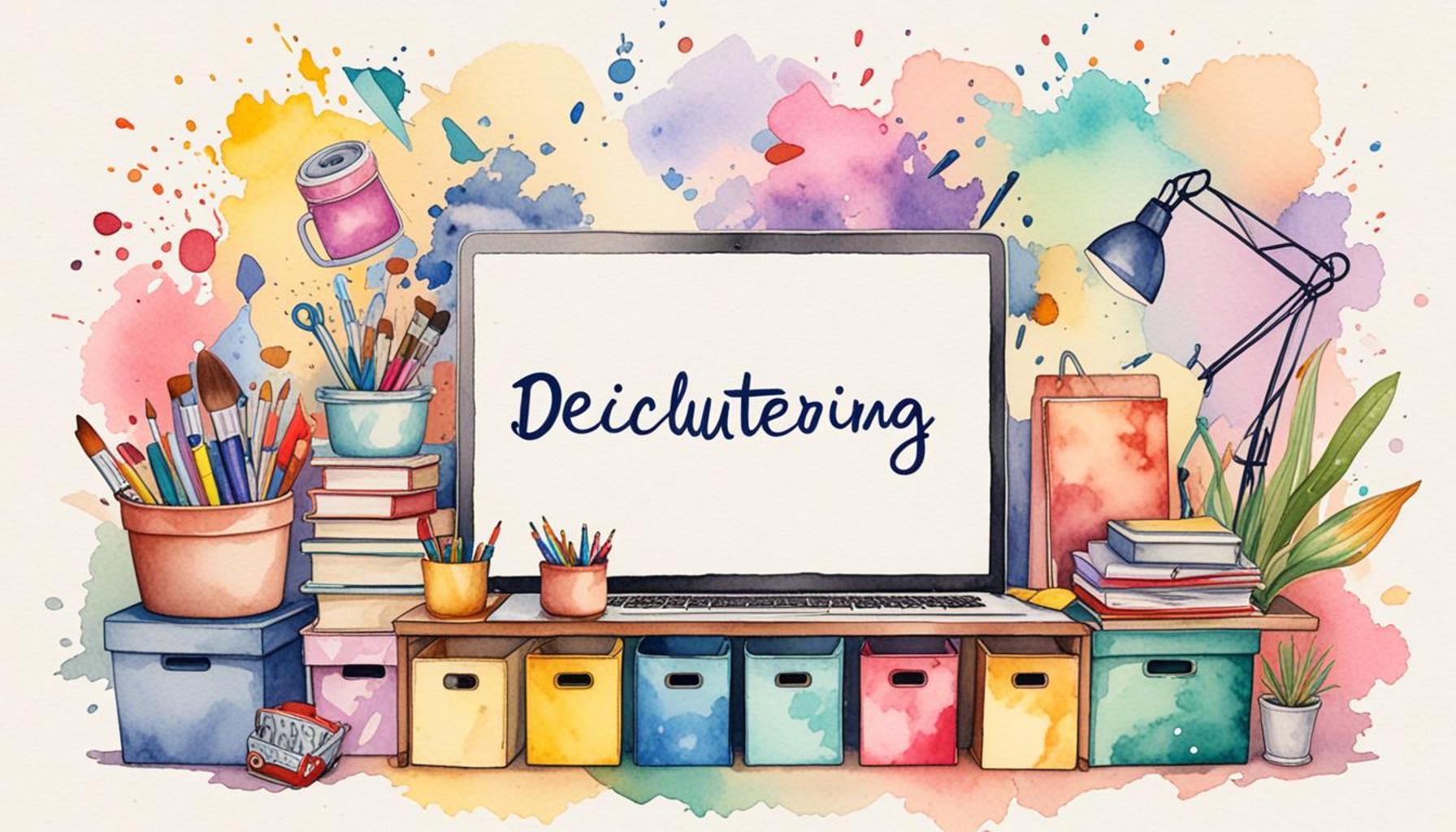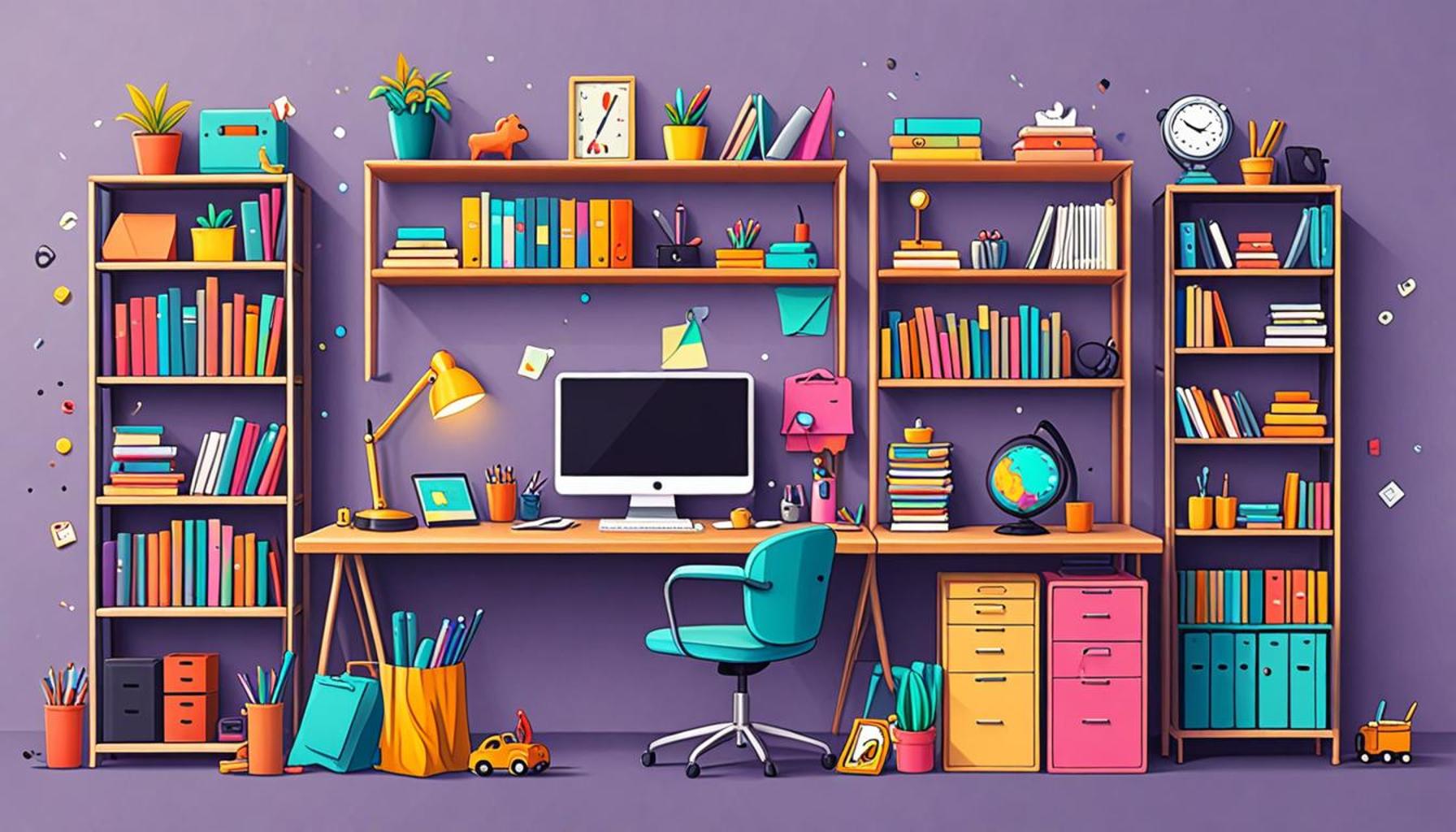Decluttering in Stages: How to Break Down the Process to Avoid Overwhelm

The Power of Decluttering
Feeling overwhelmed by clutter is a common struggle for many. The sensation of being buried under a mountain of possessions can create anxiety and stress, making it challenging to find the motivation to tackle the chaos. As such, one of the keys to transforming your surroundings into a serene sanctuary lies in breaking down the decluttering process into manageable stages. This approach not only simplifies the task but also makes it far less intimidating.
Preparation
Before diving headfirst into decluttering, it’s crucial to prepare your space. Begin by gathering essential supplies, such as boxes, trash bags, sticky notes, and markers. Boxes can be used for items you wish to donate or sell, while trash bags will help you dispose of items that are no longer useful. Additionally, consider labeling each box with its intended purpose, such as “Donate,” “Keep,” or “Sell”. This clarification can streamline your decision-making process and make it easier to categorize your belongings.
One Room at a Time
A common pitfall in decluttering is attempting to tackle multiple areas simultaneously, which can lead to feelings of being overwhelmed. To combat this, focus on one room at a time. Start small, perhaps with a closet, kitchen drawer, or even a single shelf. By concentrating your efforts, you allow yourself to witness immediate progress, which can be incredibly motivating. For instance, sorting through a jewelry box may uncover pieces you forgot you owned, prompting you to keep only what you truly love, while letting go of outdated or broken items.
Set Time Limits
To make the decluttering process even more manageable, it’s helpful to set time limits for each session. Dedicating 20-30 minutes at a time can prevent burnout and help maintain your energy and motivation levels. Use a timer to keep track, and don’t be afraid to take breaks when needed. These short bursts of focused effort can yield significant results over time without feeling like a monumental chore.
Benefits of Decluttering
Engaging in decluttering can lead to numerous advantages beyond just a neat home. For many, a well-organized space promotes increased mental clarity and improved productivity. Research has shown that clutter can significantly impede an individual’s ability to focus, leading to feelings of stress and anxiety. Conversely, a clean environment can enhance brain function and inspire creativity. Psychological studies indicate a direct correlation between physical space and mental well-being, suggesting that reducing clutter can even enhance your overall mood.
Celebrate Small Wins
As you embark on this journey towards a more organized life, it’s vital to celebrate small wins. Each item you remove brings you one step closer to a peaceful environment. Create a visual checklist to track your progress—seeing how far you’ve come can serve as a powerful motivator. Remember, it’s not just about the end goal; it’s about enjoying the journey and the incremental improvements that enrich your living space.
Conclusion
By adopting a staged approach to decluttering, you transform what is often perceived as a daunting task into a series of achievable goals. Whether you are looking to simplify your space, gain greater control over your possessions, or create a more mindful living environment, a methodical and strategic plan can lead to a significant positive change. So gather your boxes, set your timer, and get ready to reclaim your home—one room at a time.
DISCOVER MORE: Click here to learn about minimalist design’s impact
Understanding the Stages of Decluttering
Approaching the process of decluttering can feel like standing at the foot of a towering mountain, where each pile of clutter seems insurmountable. However, by breaking down the undertaking into specific stages, you can inch your way toward a cleaner, more organized space. This method not only alleviates anxiety but also fosters a sense of accomplishment as you make steady progress. Understanding these stages is essential for maintaining motivation and perspective throughout the journey.
The Decision-Making Stage
The first stage involves decision-making. It’s pivotal to evaluate each item and determine whether it truly belongs in your home. Ask yourself questions like:
- When was the last time I used this?
- Does this item have sentimental value, or is it just taking up space?
- Do I have duplicates of this item?
Utilizing these reflective questions can help you sift through your possessions critically. Maintaining a mindset focused on your desired outcome is essential—what kind of space do you want to create? This foundation will guide you in deciding whether to keep, donate, or discard items.
The Sorting Stage
Once you’ve made preliminary decisions, the next step is to sort your belongings into distinct categories. This can be done in a variety of ways, such as by:
- Type of item (clothing, electronics, books).
- Room or area (bedroom, living room, garage).
- Functionality (items you use often versus those that rarely see the light of day).
Creating these categories helps you visualize the extent of your possessions and reveals duplicates or items that can easily be removed. Not only does sorting clarify what you have, but it also opens your eyes to items that may contribute to an excess of clutter.
The Disposition Stage
After sorting and decision-making comes the disposition stage. This is the part that many individuals find cathartic, as it involves actively removing clutter from your space. Here, you can:
- Place items in the designated donation box and schedule a drop-off.
- List valuable items for sale online or at a local consignment shop.
- Dispose of items that are no longer functional or useful.
Engaging in this stage can have a profound emotional impact as you release the physical representations of your past. By following through with your decisions, you are actively freeing not just your space, but also your mind and spirit.
The Maintaining Stage
The final stage is one of maintenance. Once you’ve successfully decluttered, you must also build habits to ensure the clutter doesn’t creep back in. Establish a routine of regular evaluations, perhaps monthly or seasonally, and incorporate the same questions you used during the decision-making stage. Remember that consistency is key to maintaining a clutter-free environment.
By understanding and embracing these stages of decluttering, you set yourself on a path to achieving an organized life that aligns with your values and goals. Each stage is tangible and offers clear direction, making the overall journey not only easier but also significantly more rewarding. Armed with this knowledge, you’re ready to dive deeper into the decluttering experience—rest assured, the end goal will be worth every effort.
Understanding the Phases of Decluttering
When delving into the approach of decluttering in stages, it’s essential to grasp the various phases involved. This method doesn’t just make decluttering more manageable; it fundamentally transforms the way one perceives their living space. Here are several critical stages that can facilitate a smoother transition toward a more organized life.
1. Assessment
In this initial phase, surveying your surroundings is crucial. It isn’t just about viewing what’s cluttering your space but also understanding the emotional and practical implications of these items. Asking yourself guiding questions like, “How does this item make me feel?” or “Have I used this in the past six months?” can provide clarity.
2. Categorization
Once you’ve assessed your belongings, categorization comes into play. Break your items into distinct categories such as keep, donate, sell, or discard. This tactic doesn’t only simplify decision-making but also allows you to visualize the progress you’re making. Consider utilizing bins or boxes to sort these categories effectively.
3. Time Management
Setting aside specific time slots dedicated to decluttering is essential. A common misconception is that decluttering needs to be completed in a single day. In reality, dedicating as little as 15 to 30 minutes a day can lead to significant results. Scheduling consistent sessions can also instill a sense of routine, making the process feel less daunting.
4. Reflection
After a decluttering session, take time to reflect on what you’ve accomplished. Acknowledging your progress—no matter how small—can reinforce positive behavior and motivate further action. Consider keeping a journal to document these reflections and the feelings associated with each decluttered session.
Incorporating journaling or meditation during these breaks can help reveal underlying attachments you may have to certain items, providing deeper insights into your relationship with your belongings.
Emphasizing these stages empowers individuals to regain control, witnessing their spaces evolve with each effort. With a clear framework to follow, decluttering becomes less of an overwhelming chore and more of an empowering journey.
| Category | Benefits |
|---|---|
| Emotional Clarity | Decluttering in stages helps to reduce emotional strain by allowing individuals to process their feelings toward items gradually. |
| Increased Productivity | Organizing space step-by-step leaves less chaos, resulting in enhanced focus and productivity in daily activities. |
These benefits not only ease the burden of decluttering but also foster a deeper understanding of one’s environment and emotional attachments. With a structured approach, anyone can conquer the clutter and create a sanctuary that inspires peace and productivity.
DIVE DEEPER: Click here to learn more about technology and minimalist living
Practical Tips for Each Decluttering Stage
As you embark on your decluttering journey, it’s essential to equip yourself with practical tips tailored to each stage. These strategies not only enhance your efficiency but also encourage you to stay engaged, transforming a daunting task into a rewarding experience.
Tools for Effective Decision-Making
During the decision-making stage, having the right tools can streamline the process. Consider setting up a clear workspace equipped with:
- Containers for sorting items into “keep,” “donate,” and “discard” categories.
- Labels to mark each container, making it easy to remember your decisions.
- A checklist to document items that contribute to clutter, helping you stay organized.
Additionally, referencing resources that provide insight on minimalism can inspire you to release attachments to unnecessary possessions. Books like “The Life-Changing Magic of Tidying Up” by Marie Kondo can serve not only as motivators but also offer different perspectives on what to keep and why.
Dynamic Sorting Techniques
In the sorting stage, keeping the engagement levels high is crucial. Experiment with various sorting techniques to find what works best for you:
- The Four-Box Method: Label four boxes as “Keep,” “Donate,” “Sell,” and “Trash.” Visually seeing the boxes can create a sense of urgency to fill each section.
- The One-Year Rule: If you haven’t used an item in over a year, it may be time to let go. This is particularly useful for clothing and seasonal items.
- One Touch Rule: When handling items, make the decision immediately to either keep or let go, thereby reducing indecision and procrastination.
Consider using digital organizing tools or apps that help track your items, especially for seasonal decluttering. For instance, an inventory app can be helpful in sorting through electronics or kitchen gadgets.
Clever Disposition Strategies
Next, moving into the disposition stage, think creatively about how to let go of your unwanted items. Here are several strategies that can assist in this phase:
- Community Swap Events: Organize or participate in local swap meets to exchange items with others, allowing for a sense of community engagement.
- Hosting a Garage Sale: This not only lets you earn some extra cash but also creates a fun atmosphere for you and your neighbors. Consider using social media to promote your sale widely.
- Eco-Friendly Options: Look into donation centers that recycle or responsibly dispose of unwanted items, ensuring that your decluttering efforts benefit others while being environmentally conscious.
Effective disposition isn’t only about clearing space; it’s about ensuring that your items continue to serve a purpose, thereby reducing waste.
Building Long-Term Maintenance Habits
Finally, the success of your decluttering efforts hinges on the maintenance stage. Establishing sustainable habits can help you prevent a clutter resurgence:
- The One In, One Out Rule: Commit to letting go of one item for every new item that enters your home, helping to keep clutter at bay.
- Monthly Review Sessions: Set aside time each month to review your belongings and reassess whether everything still aligns with your current lifestyle.
- Designate Clutter-Free Zones: Identify specific areas in your home where clutter is not permitted, such as countertops or dining tables, reinforcing the mindset of a tidy living space.
Incorporating these practices will not only help you maintain a clutter-free environment but will also create a lasting influence on your overall lifestyle, making organization feel effortless rather than burdensome.
DISCOVER MORE: Click here to unlock innovative storage solutions
Conclusion
Embarking on a decluttering journey can initially seem overwhelming, but breaking down the process into manageable stages can transform it into an empowering experience. By following the structured approach of decision-making, sorting, disposition, and maintenance, individuals can conquer clutter without the stress often associated with large-scale organizing tasks.
Each stage serves a purpose: from making thoughtful decisions about what truly adds value to your life, to implementing dynamic sorting techniques that keep you engaged. The clever disposition strategies discussed not only help clear space but also promote environmentally responsible habits through donations and recycling. Moreover, establishing long-term maintenance practices solidifies the foundation of a clutter-free lifestyle, ensuring that your newly organized environment remains sustainable.
Consider this journey as an opportunity for self-reflection and improved well-being. A clutter-free space can lead to a clutter-free mind, enhancing creativity and productivity. Therefore, take the leap—start with small, incremental changes and gradually achieve a harmonious home. For additional support, engage with community resources, read literature on minimalism, or explore organizing apps that will further aid your decluttering process.
Ultimately, the goal is not just to remove excess belongings, but to enrich your life with intentionality and purpose. By embracing this staged approach to decluttering, you’ll find that less truly is more—a powerful realization that can change your living space and, in turn, your life.



